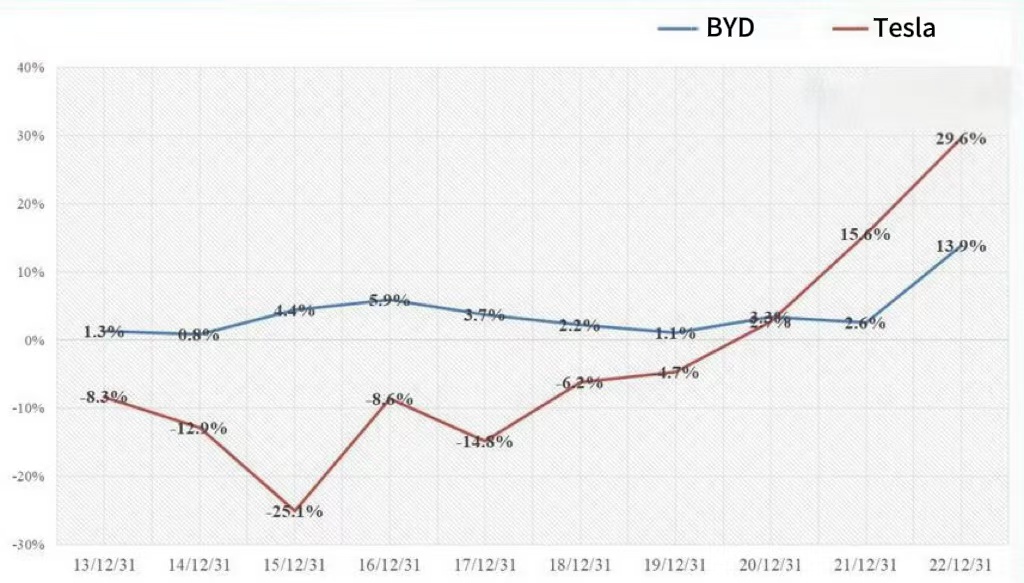1. Introduction
This study examines the business strategies of Tesla and BYD, the leaders in the electric vehicle market, which have shaped the industry's growth through technological innovation competition, business strategy differentiation, and superior market performance. It does this by combining quantitative and qualitative methods. The rivalry between the two automakers gives customers more options, which promotes the advancement and ubiquity of electric vehicle technology. As the demand for clean energy grows globally, Tesla and BYD are anticipated to maintain their prominent leadership positions in the electric vehicle market. In other words, Tesla's marketing outcomes are more noteworthy, particularly given that the company's stock price has increased more quickly than BYD's during the market's explosive growth.
2. Tesla marketing model birth background
Tesla's state-of-the-art research staff and cutting-edge technologies are among its advantages. Research and development in electrical and battery technologies have bridged the gap in power batteries and established a strong basis for the company's product differentiation strategy. Tesla implements fame effects and inappropriate competition at the same time. Its initial cost is comparatively exorbitant, and the aura of numerous celebrities purchasing Tesla has successfully built a niche and upscale brand image. Following its entry into the Chinese market and the subsequent progressive opening of the market, Tesla has expanded its product line to include more affordable, mainstream models in addition to its once-exclusive line of expensive, esoteric super sports vehicles.
3. The benefits of Tesla’s unique marketing model
The market entry tactics for electric car startups in the automotive sector are examined by Thomas & Maine [1]. Tesla Motors: Some lessons. In China, Tesla has implemented a brand-building plan. While sales have been trending steadily since entering the Chinese market, it has yet to occupy much of it. In order to gain a larger portion of the market, Tesla built a "super factory" in Shanghai, made improvements in the supply side, and put appropriate marketing plans into place. According to CPCA data, China's total sales in 2019 were 49,156 units, or 6.8% of total sales, of which were purchases from outside the country. Tesla's market share increased to 15.1% in 2020 when the "Gigafactory" was completed and put into production, with a total sales volume of 138,505 vehicles, a twofold increase over the previous year. Additionally, Tesla has used effective and distinctive marketing strategies to develop a strong brand position quickly. Until now, it has led the new energy car market and gained a lot of devoted customers because of its superior technology and innovative design. Utilize the celebrity effect to the fullest extent possible as a high-end sports automobile to attract attention and purchases from your target market. As a result, Tesla keeps showing up on social media by providing experience consumption for various celebrities and business owners. This introduces a wide range of subjects to the brand and helps to shape its image as a high-end, stylish one. Tesla uses a paradigm of an open ecological chain. Many vendors from across the world have congregated in Tesla's supply chain. For instance, Panasonic of Japan, LG Chem of South Korea, and CATL of China already supply power batteries to Tesla. In order to provide consumers with a complete understanding of Tesla's goods and culture, the company simultaneously prioritizes customer experience and operates several physical experience locations throughout the globe. In order to construct a vehicle that meets the needs and preferences of the customer, it may also be modified. Mangram conducted a strategic marketing strategy review of Tesla Motors worldwide [2].
4. Marketing comparison between Tesla and BYD
Like Tesla, BYD is a frontrunner in the emerging field of new energy automobiles, and both businesses are dedicated to market expansion.
Brand perception: Whenever this brand brings up its automobiles, its attributes come to mind [3]. For example, BYD is a pioneering Chinese brand that began investigating alternative energy automobiles.
Brand reputation: The degree to which consumers favor and trust a brand reflects the brand's perceived value [4]. For BYD, there will be a strong correlation between product sales success and brand recognition. Customers will be more inclined to purchase BYD goods the more individuals know about and comprehend the company.
Self-image congruence: This refers to the degree to which BYD's intended message aligns with the actual perceptions of its target audience. The more closely the two match, the more successful the branding [5].
Subjective norm: Friends, family, coworkers, neighbors, and others frequently impact consumers' purchasing decisions [6]. For instance, some customers want to purchase a product because a buddy recommended it.
Perceived Behavioral Control: The company's anticipated challenges throughout the BYD car pre-purchase phase mostly represent perceived behavioral control. Customers' power over the buying process will readily translate into their intent to acquire BYD's new energy cars if the procedure isn't already challenging [7].
Environmental attitude: The way customers feel about BYD's efforts to safeguard the environment can be either positive or negative. Because new energy cars are excellent for the environment, consumers could purchase them. Customers, meanwhile, favor purchasing environmentally friendly green items. However, they would still consider the product's cost and quality [8].
When it comes to marketing, Tesla is separated into four areas.
(1) precise placement in the market Tesla When it first started, it made it obvious that it would only sell elegant, stylish electric cars. Consumers are drawn to well-off individuals because they are more likely to be open-minded and environmentally conscious. Tesla's premium style and energy-efficient posture appeal to this demographic.
(2) Online sales models and offline experience shops After making an online purchase and experiencing the model in person, customers can have the automobile shipped straight from the manufacturer to their home. Prepayment and manufacturing thereafter create a large amount of cash flow for the buy model. Because it never relies on labor, Tesla avoids the usual ineffective method of promotion and saves money by using the Internet to address all of its problems.
(3) The model updates quickly. To keep customers feeling new, Tesla has revised the benefits and drawbacks of each model, and updates are made every few months.
(4) The creation of the industrial structure Regarding power batteries and management systems, Tesla has conducted extensive research, development, and testing. The grasp of core technologies has set the cornerstone for its steady development. Grow the industrial system as a whole. Not only will this advance the standardization of electric car charging, but it will also enable Tesla to make charging stations more affordable. The "three electricity" model, represented by batteries, motors, and electronic controls, is BYD's fundamental technology. More recently, the company has made advancements in energy storage. BYD has implemented the "three electric + energy storage + vehicle" model in its industrial structure. BYD has been active in the electric and plug-in hybrid vehicle industries, from parts to whole automobiles. The company can even create some automotive semiconductors independently, thereby becoming self-sufficient. Both Tesla and BYD are dedicated to expanding their marketing efforts into foreign markets, and both initially focus on high-end consumers in the early stages of the market. For instance, both use the investment and factory construction models, and BYD selects the two primary models of export and strategic alliance; Tesla, on the other hand, primarily uses the "direct management" model, deploying franchises to establish directly operated stores and service centers across the US, Europe, Asia-Pacific, and other regions in order to expand its business internationally.
5. Development status
When comparing Tesla's (stock price movement) to BYD, the two months with the biggest increases and decreases were August 2020 and May 2013, with 74.15% and 81.07%, respectively. Specifically, in 2020, Tesla sold around 500,000 new vehicles globally, coming very close to its sales goal at the start of the year by providing various goods at cheaper costs in China and other regions. Analysts predict that Tesla will make $2.3 billion in profit in 2020, a 92% increase over 2019. Figure 1 shows the comparison of stock price changes between Tesla and BYD.

Figure 1: The comparison of stock price changes between Tesla and BYD
6. Conclusion
Regarding brand influence, Tesla is unquestionably a well-known and loved automobile brand worldwide. Despite its strong performance in the home market, BYD still has to increase its impact abroad. In addition to its cutting-edge technology and upscale design, Tesla's brand influence stems from its effective layout and marketing approach in the international marketplace. In contrast to BYD, Tesla has a more successful marketing strategy. On the one hand, it has effectively entered the Chinese market and enjoys a positive brand reputation among Chinese customers. On the other hand, its wide range of products at competitive prices appeals to a wider customer base, which has resulted in a surge in sales.



